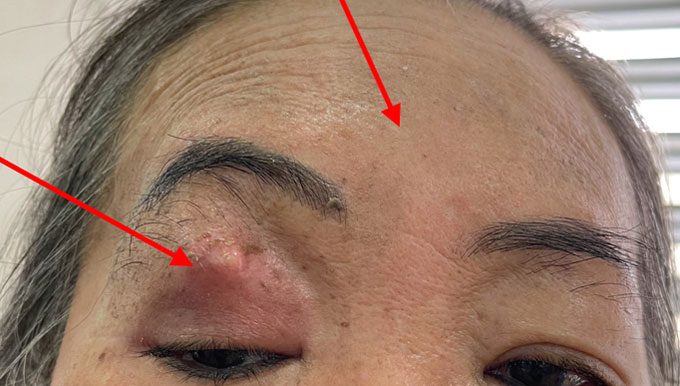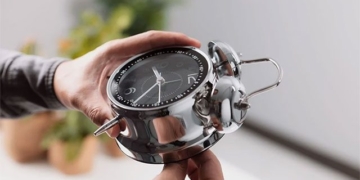Depending on the area of necrosis, patients may experience symptoms such as facial swelling, eye pain, headaches, loose teeth and jawbone, pus drainage, painful swelling of the palate, ulcers, and exposed upper jawbone…
Recently, several hospitals in Ho Chi Minh City, such as the Central Dental Hospital, Ear, Nose, and Throat Hospital, and Cho Ray Hospital, have received many patients with necrosis of the cranial and facial bones, with two reported fatalities. Notably, the number of patients with unexplained upper jaw necrosis has increased unusually, as previously, hospitals only occasionally treated patients with lower jaw necrosis due to cancer radiation therapy or diabetes-related issues. The doctors have yet to determine the cause of bone necrosis in recent patients; however, the common factor is that they all had a prior COVID-19 infection and had no history of ear, nose, throat, or dental diseases.
According to Associate Professor Tran Minh Truong, former Deputy Director of Cho Ray Hospital and President of the Head and Neck Surgery Association of Ho Chi Minh City, based on the clinical manifestations of patients and a review of global literature, doctors have identified cases of osteomyelitis of the jaw and osteomyelitis of the cranial base. Previously rare, this condition has seen around 80 reported cases from May 2021 to May of this year, primarily from India, China, several Asian countries, and some European and American nations. Most patients had underlying conditions, particularly diabetes, and had experienced COVID-19 during the Delta variant outbreak.
Common Symptoms
According to Associate Professor Truong, patients reported pain in the facial area, teeth, and palate during their COVID-19 infection, which continued to progress with persistent, non-decreasing symptoms. Common clinical manifestations observed by doctors during examinations include swelling of the eyelids; swelling in the forehead area; jawbone necrosis, tooth necrosis, and palate necrosis causing chewing difficulties; severe necrosis of the nasal cavity extending to the cranial base. The disease presents with some symptoms similar to sinusitis, which can lead to misdiagnosis.

A patient admitted to Cho Ray Hospital with symptoms of headache, swollen eye, and swollen forehead on the right. (Photo: Hospital provided)
Patients in Ho Chi Minh City primarily experience necrosis of the facial bones. Dr. Nguyen Van Tuan, Head of the Maxillofacial Surgery Department at the Central Dental Hospital of Ho Chi Minh City, reported that patients typically present with symptoms such as loose teeth and jawbone, pus drainage, painful swelling of the palate, ulcers, and exposed upper jawbone.
Osteomyelitis of the cranial base is rarer and can be life-threatening. According to RSNA Journals, this is a infection of the temporal bone, sphenoid bone, or occipital bone. The disease is difficult to diagnose due to atypical symptoms, prolonged clinical progression, and X-ray images that can be confused with other conditions. Patients often present with nonspecific symptoms such as headaches and facial pain. Most cases begin with external ear infections, presenting with severe pain and pus discharge; in some severe cases, this can lead to hearing loss. In other cases, patients may experience sinusitis, resulting in nasal congestion, runny nose, headaches, and fever.
Severity of the Condition
The first two patients admitted to Cho Ray Hospital underwent sinus surgery and showed improvement; however, imaging revealed abnormal bone necrosis. Doctors recommended further surgery, but the patient, feeling normal, declined. Subsequently, the patient experienced rapid multi-organ failure, and despite medical efforts, the situation was not salvageable.
Among the patients in Ho Chi Minh City, one case involved a patient with a fungal sinus infection that became invasive, destroying bone, leading to blindness after a tooth extraction. Another female patient from Kien Giang experienced necrosis of the palate, requiring the removal of dead bone and most of her teeth during surgery.
According to Dr. Tuan, if the necrotic bone is not removed, it can become a localized site for bacteria, potentially leading to septic shock and life-threatening bloodstream infections. Early detection and timely intervention can prevent the progression of bone necrosis; however, if left unchecked, necrosis can spread to the cranial floor, increasing the danger.
In cases of cranial bone necrosis, if the infection spreads to the brain, it can lead to meningitis, brain abscesses, and death.
Causes of the Disease
Dr. Le Quoc Hung, Head of the Tropical Diseases Department at Cho Ray Hospital, stated that the causes of bone destruction are often due to vascular occlusion, reduced blood supply leading to necrosis, or external factors such as microbial attacks causing bone infections.
To date, experts have not been able to confirm whether this disease is related to COVID-19. Doctors hypothesize that individuals who have had COVID-19 may experience prolonged immune dysregulation, combined with pre-existing underlying conditions, which could lead to increased fungal growth in the body, causing infections. Normally, the surrounding environment contains various microorganisms; when the immune system is compromised due to illness, the body becomes more susceptible to bacterial and fungal attacks.
According to Dr. Tuan, literature identifies four risk factors for upper jaw necrosis. First, the SARS-CoV-2 virus binds to ACE2 receptors (which are abundant in the mucous membranes of the nose and mouth), causing vascular complications that can lead to blood flow obstruction to the bones. Additionally, COVID-19 can cause increased blood clotting and reduced blood supply to the bones, resulting in necrosis. Furthermore, the use of corticosteroids (anti-inflammatory) in COVID-19 treatment protocols may impair bone nourishment. Other risk factors include opportunistic infections by bacteria and fungi. Lastly, patients with underlying conditions, especially diabetes, are more prone to bone necrosis as the disease reduces blood supply and immune resistance, affecting leukocyte function, making them more susceptible to superinfections…
In India, some experts believe that the cause of fungal infections leading to bone necrosis is due to patients using steroids for treatment upon hospitalization. Additionally, during the second wave of the pandemic, many families had to self-medicate and provide oxygen to relatives at home without proper sanitation. Experts believe that overcrowding and a lack of medical oxygen during the pandemic facilitated the increased growth of fungi.
Arunaloke Chakrabarti, a microbiologist at the Indian Institute of Medical Research and Education, stated that many doctors prescribed steroids in excessive amounts, far exceeding the recommendations of the World Health Organization (WHO). Such steroid levels damage the immune system, making COVID-19 patients more susceptible to fungal spores. Steroids can also dangerously elevate blood sugar levels, making diabetic patients more vulnerable to black fungus, increasing the risk of blood clots and malnutrition.
In light of the rising number of cases, Ho Chi Minh City Health Department Director Tang Chi Thuong announced plans to establish a professional council comprising about 20-30 experts, with a workshop scheduled for July 21 to evaluate the disease. To gather comprehensive data and information about this condition, hospitals are compiling statistics on the admission and treatment of cranial and facial bone necrosis cases in recent times. “Experts will provide initial assessments of the issues related to this condition based on scientific evidence, continue to investigate related factors, and avoid hastily attributing the cause to COVID-19, as this could create panic among the public,” said Mr. Thuong.
Treatment and Recommendations
The principle of treating bone necrosis is to surgically remove the affected bone, followed by aggressive antibiotic and antifungal therapy for a minimum of three weeks, which may extend up to six months, while monitoring the risk of recurrence. Once the patient’s condition stabilizes, doctors will consider reconstructing and restoring the bone.
Patients who have had COVID-19 and experience symptoms such as headaches, jaw pain, or facial swelling should seek medical attention.



















































